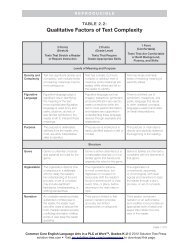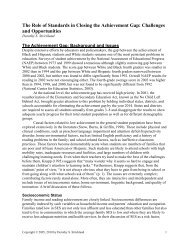Global Education Digest 2012 - International Reading Association
Global Education Digest 2012 - International Reading Association
Global Education Digest 2012 - International Reading Association
You also want an ePaper? Increase the reach of your titles
YUMPU automatically turns print PDFs into web optimized ePapers that Google loves.
OPPORTUNITIES LOST: THE IMPACT OF GRADE REPETITION AND EARLY SCHOOL LEAVING<br />
Duration. The number of grades or years in a given level of education.<br />
Early childhood care and education (ECCE). Programmes that, in addition to providing children with care,<br />
offer a structured and purposeful set of learning activities either in a formal institution (pre-primary or ISCED 0)<br />
or as part of a non-formal child development programme. ECCE programmes are typically designed for children<br />
aged 3 years and over, occurring before primary education, and include organized learning activities that last on<br />
average an equivalent of at least two hours per day and 100 days per year.<br />
<strong>Education</strong> finance<br />
<strong>Education</strong>al expenditure by nature of spending as a percentage of total educational expenditure<br />
on public institutions, by level. Spending by nature (salaries, other current, total current or capital)<br />
expressed as a percentage of the expenditure for public educational institutions of the specified level of<br />
education. Salaries and other current expenditure add up to total current expenditure. Public subsidies to<br />
the private sector and administrative costs are excluded.<br />
Public expenditure per pupil or student by level as a percentage of GDP per capita. Total public<br />
expenditure per pupil or student in the specified level of education expressed as a percentage of GDP per<br />
capita.<br />
Total public expenditure per pupil or student by level (PPP US$). Total public expenditure per pupil or<br />
student in the specified level of education expressed in U.S. dollars and adjusted in terms of purchasing<br />
power parity (PPP).<br />
Total expenditure on educational institutions and educational administration as a percentage of<br />
GDP, by source. Expenditure from public, private and international sources on educational institutions (i.e.,<br />
schools, universities and similar instructional institutions) and administration at a given level of education,<br />
expressed as a percentage of GDP. This indicator excludes public subsidies to the private sector. As a<br />
consequence of this, data on public expenditure on educational institutions and educational administration<br />
differ from total public expenditure on education.<br />
Total public expenditure on education as a percentage of GDP. Current and capital expenditure on<br />
education by local, regional and national governments, including municipalities (household contributions<br />
are excluded), expressed as a percentage of GDP.<br />
Total public expenditure on education as a percentage of total government expenditure. Current<br />
and capital expenditure on education by local, regional and national governments, including municipalities<br />
(household contributions are excluded), expressed as a percentage of total government expenditure on all<br />
sectors (including health, education, social services, etc.).<br />
<strong>Education</strong>al attainment. The educational attainment of an individual is defined as the ISCED level<br />
corresponding to the highest educational programme completed successfully.<br />
<strong>Education</strong>al attainment of the population aged 25 years and older. Percentage distribution of the population<br />
aged 25 years and older according to the highest level of education attained or completed with reference to<br />
ISCED.<br />
63

















